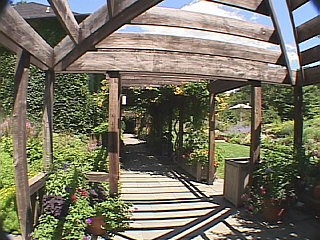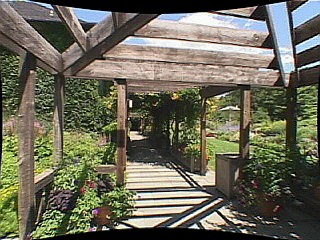| On
Seeing and Perspective DAVID RUETHER |
|
In article <4tugt9$kcd@newsbf02.news.aol.com>, stevet5710@aol.com says...
Ah, you have asked the basic question! Many feel that comparing our vision to
photographic processes and equipment is irrelevant, since they hold the opinion that there
are too many differences between the two to make a comparison valid. I think they are
wrong. What we see, I will take "distortion" first. It is a word that should be used carefully (but often isn't in photography), since it refers to specific things. There are several types of perspective (rectangular [which most camera lenses approximate], cylindrical [as seen in swing-lens panoramic camera images], spherical [otherwise known as "fisheye"], orthographic fisheye [similar to spherical, but with less curvature of off-center straight lines over most of the field, but more near the edge], the "non-perspective" "quasi-isometric" projections of old Japanese paintings and drawings and many architectural and engineering drawings [in which there is no convergence], and possibly a few other types). If the image perspective follows the rules of the perspective type used, technically there is no "distortion", odd as the image may appear. You have noticed that the image made by most photo lenses that even begin to be "wide-angle" (wider in coverage than the "normal" angle of view of a photo lens, usually defined as being produced by a focal length approximately equal to the diagonal of the image area) appears different in perspective (and perspective effects) than what you see, even though the angle covered is far smaller. (If you look carefully, even the "normal" photo lens image is quite different in perspective characteristics from what we see.) The reason is simple: we don't see in rectangular perspective! (BTW, most people can see illumination somewhat beyond 180 degrees of coverage - this is another indication of non-rectangular perspective vision: angles of view approaching 180 degrees are impossible in rectangular perspective due to the enormous size of the image area and/or the impractical shortness of focal-length of the lens required to produce the image [in addition to very serious illumination problems].) For the key to beginning to understand what we see, a look at the eye structure (and its surroundings) is in order. The eye is (roughly) a sphere with a single-element lens placed somewhat below the surface of the front, with a photo-sensitive area occupying approximately the rear half of the interior surface of the sphere (photo sensitivity in this area is not uniform - greater color and sharpness capability is concentrated near the center, with greater low-light sensitivity appearing off-center). The lens is somewhat forward of the front edge of the light sensitive hemispherical area. The eye sits in a facial surround (eyebrows, cheeks, eye-lids, eye-lashes, etc.) which, combined with the characteristics of the eye structure, limit the field of the two eyes combined to an illuminated view of about 180-200 degrees horizontal by about 110-120 degrees vertical (this varies somewhat among individuals, depending on the particulars of their physical structures) - with a rounded and softened field edge (see an approximation here). Within that field, sharpness and color perception is not uniform, with excellent sharpness possible only in a very small central area, though useable sharpness and color sensitivity may extend out to about 160-180 degrees. Most peoples' attention is concentrated in a VERY small area near the center of the field, with some of the remaining field surrounding the center being used for (unattended) context for the center, and with the area near the edge of the field being used only to perceive light and motion. Given the above, it is possible to construct an approximation, in photographic terms, of what we see. In the very small central area (normal attended area), If we go back and look at the structure of the eye, it If this is true, and if the brain does not "correct" the spherical (fisheye) perspective back into rectangular perspective, what are the characteristics (and advantages) of spherical perspective that we should see? One is that rounded objects at normal distances (like people and cars) are not "squashed" (example here) when moved away from the center of vision (as they are in even moderately wide-angle rectangular-perspective photographs). Another is that, over the more limited vertical angle that we see, subject verticals at normal distances (like trees and buildings) remain approximately vertical and parallel with each other when we look somewhat up and down (example here - unlike what happens when tilting even moderately wide rectangular-perspective camera lenses). A third is that near-to-far subject proportions do not look exaggerated (as they can appear to be in many photographic rectangular-perspective wide angle images - example here). These are characteristics common to both cropped fisheye camera images and our vision. The one bugaboo of photographic fisheye images, though, is the curvature of off-center straight lines. This is most apparent when the subject is abnormally close to the lens, (causing the subject to occupy a large part of the field), or when a long straight line in the subject (like a horizon line) crosses a large proportion of the image field off center (example here). In vision, our limited vertical angle of view (which limits the range of curvature), our reduced field-edge resolution (which helps limit the range of visible curvature and other fisheye image edge effects), and our tendency to attend only to a narrow angle of view at the center of our field of vision (where all perspective types are similar) help to conceal the most obvious differences between spherical perspective and the familiar rectangular perspective produced by "normal" (and somewhat longer) photographic lenses. With a little training, the curvature of long off-center straight subject lines
extending across most of the field of vision can be clearly seen, thus ending any misunderstanding about what type of perspective we use in seeing. If you have little or no
experience with attention point (and area) shifting within your field of view (without
changing eye direction), you can begin by looking 10 or 15 degrees away from something
that is very easy For more, see my article, "On Lens Perspective Types". In the images below, the first was shot with a video camera with a wide-angle attachment added, the second is the same image (with about the same angle of view), but with the "distortion" digitally corrected out (full story here - and also see Helmut Dersch's interesting article on perspective here [or at www.all-in-one.ee/~dersch - which includes Pro Tools]). As you can imagine, with camera tilt or pan, the shift in perspective would be minimal in the first view, possibly quite disturbing in the second; the near-to-far proportions are more "normal" in the first view; and (not shown, but indicated by the increased width of the vertical supports near the edge of the the second image compared with those in the first) people moved near the edge in the second frame would grow "un-naturally" in width. So, take your choice: curvature of straight lines off center, but otherwise a more "natural"-looking wide-angle image; or, little or no curvature of straight lines, but with several other serious drawbacks evident in the wide-angle image. I prefer the second for architecture, but for most other things, the first...
"Hope This Helps"
|

